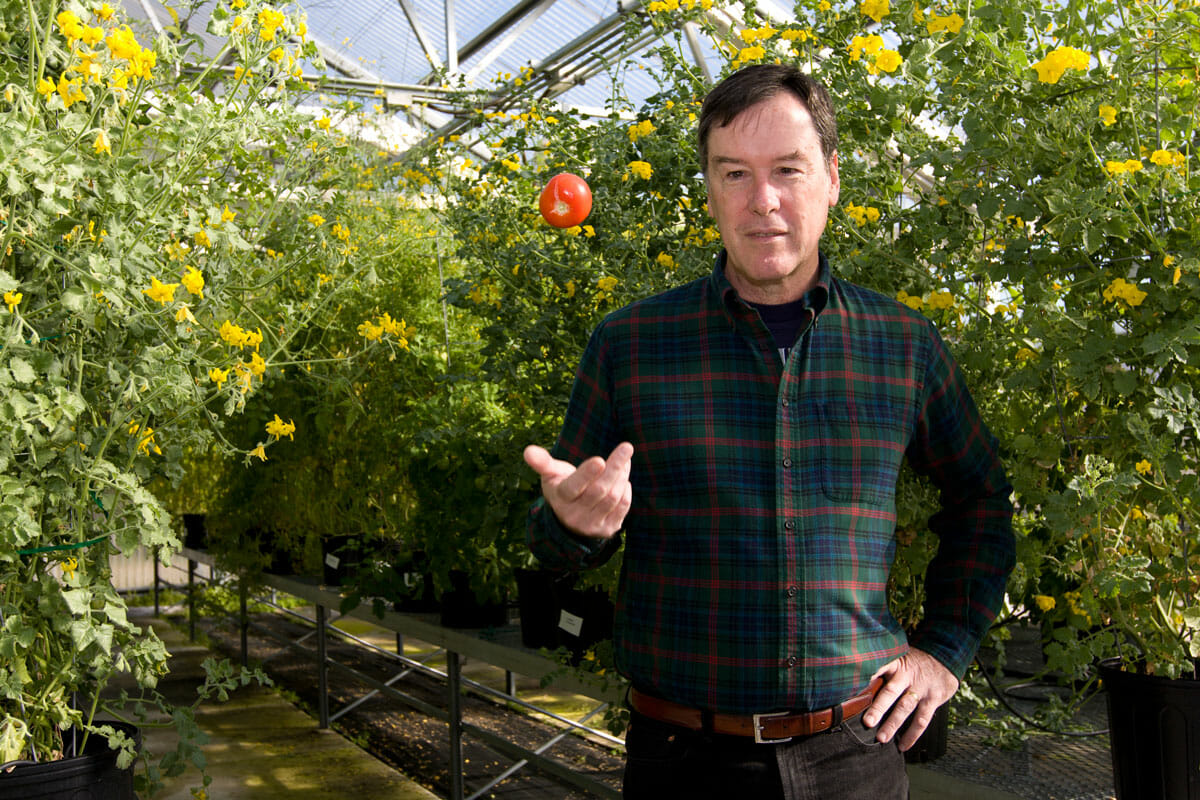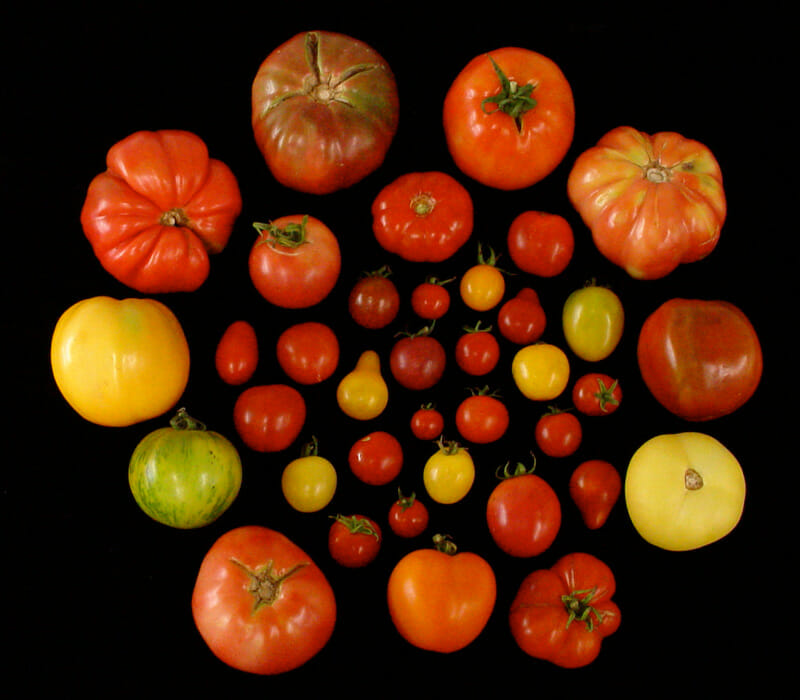Building a Better Tomato Through the Sense of Smell
How a molecular biologist and horticulturist at the University of Florida is attempting to make mass-produced tomatoes taste better, using the cutting-edge science of how taste and smell interact.
Building a Better Tomato Through the Sense of Smell
How a molecular biologist and horticulturist at the University of Florida is attempting to make mass-produced tomatoes taste better, using the cutting-edge science of how taste and smell interact.

What’s wrong with the tomatoes we eat now? A few things, Klee explains, giving a rundown of today’s heirloom status quo. Number one is that growers are not paid to produce great-tasting fruit. They are paid for yield, for how many pounds of tomatoes “they put in boxes,” he says, rather than for how savory their product is. For years, tomato breeders focused exclusively on yield, creating varieties that deliver huge amounts of fruit in a very short time. But plants just can’t produce enough chemicals to make all those tomatoes tasty.
“The plant can’t keep up with the fruit load,” Klee says – they’re maxed out. “They only have so much energy.”
The second problem is the post-harvest handling. Most mass-produced tomatoes are refrigerated after they’re picked – and that kills flavor. We think of tomato as a vegetable, but it’s actually a tropical fruit not built to withstand low temperatures, Klee says. Even when picked, a tomato remains a living organism, going through chemical reactions and producing compounds that contribute to its taste. Refrigeration interferes with tomato’s natural ripening – it undergoes a shock it never recovers from.
“It’s like you’re throwing sand into the machines and all the gears are getting gummed up,” Klee says. “That’s a terrible thing to do to a tomato, and everybody knows it, and everybody does it.”
And everyone buys it, too. According to Klee, consumers share the blame for bland-tasting produce to some extent – because they’re willing to purchase it.
“I believe that if the demand was there, the growers would emphasize flavor more,” Klee says.
Yet, the problem isn’t easily fixable. Few people can afford gourmet heirlooms at $6 a pound.
“I wouldn’t pay that much money,” Klee admits.
So what’s the answer? Find a way to make mass-produced tomatoes taste better.
For years, tomato breeders focused exclusively on yield, creating varieties that deliver huge amounts of fruit in a very short time. But plants just can’t produce enough chemicals to make all those tomatoes tasty.
To improve the “industrial tomatoes,” Klee uses the cutting-edge science of how taste and smell interact. A tomato’s flavor comes from a mix of three types of compounds – sweets, acids and volatiles – molecules that we smell. Volatiles can travel through the air letting us detect all kinds of scents – from roses to manure. Volatiles play a vital role in our sense of taste, and can dramatically improve flavor.
Taste is a complex feeling which comes from a combination of your tongue’s receptors and the olfactory receptors in the back of your nose. When you chew on something and then swallow it, the air in your mouth is forced up into the back of your nose, bringing the volatiles to your smell receptors. To make sense of your culinary experience, your brain combines the signals from both receptor types. A certain combination of signals means your tomato is sweet. A different combination means it’s sour or mealy.
To build a tomato people would love, Klee investigated how the fruit’s inner chemistry played on the palate.
“We evaluated 200 different heirloom varieties, grew them and rated them,” he says.
To assess the taste, Klee worked with Charles Sims who runs the consumer lab at the University of Florida and whose research focuses on the quality characteristics of fruits and vegetables. As consumers cast their votes, the team documented which molecular compositions created flavors people liked best.

“We can then look at the particular characteristics of those tomatoes – the flavor compounds present, the amount of sugar, et cetera, and determine what characteristics are related to the liking of tomatoes,” Sims explains.
Sweet flavor is important, Klee says, but volatiles can significantly improve the taste. So he focused on the volatiles, analyzing which ones enhance flavor and how plants produce them. His team outlined the ideal combination and amounts of compounds tomatoes should have.
“We were basically able to come up with a recipe for a great tasting tomato,” he says.
But building a fruit to specs isn’t simple. Klee’s creations are non-GMO. There’s no messing with tomato genes – he breeds his varieties through standard breeding techniques, not genetic engineering. That presented practical challenges – how do you bring the good part of the genome such as great flavor without the bad parts of the genome such as low yield and disease susceptibility?
The hybrids, which the team named “Garden Gem” and “Garden Treasure”, came out savory with almost no drop in yield – they deliver about 80 percent of what their commercial cousins produce.
“We needed to extract the good genes without the bad genes,” Klee says.
The team narrowed the original list of 200 to four or five varieties consumers loved and cross-bred them with today’s mass-produced heirlooms.
The hybrids, which the team named “Garden Gem” and “Garden Treasure”, came out savory with almost no drop in yield – they deliver about 80 percent of what their commercial cousins produce.
The next step is to find a seed company to produce and sell the hybrids, and Klee says some retailers are interested. Garden Gem and Garden Treasure will be more expensive than a typical industrial tomato, but still affordable.
“If you are selling heirlooms in the grocery store at $5.00 a pound, you should be able to cut that at least by 50 percent and still make money,” he says, adding that improving tomatoes’ taste will have an important health impact. “People will eat more of them – and that’s a good thing for their diet and a good thing for society.”
SaveSave
SaveSaveSaveSave
Follow us
This work is licensed under a Creative Commons Attribution-NoDerivatives 4.0 International License.
Want to republish a Modern Farmer story?
We are happy for Modern Farmer stories to be shared, and encourage you to republish our articles for your audience. When doing so, we ask that you follow these guidelines:
Please credit us and our writers
For the author byline, please use “Author Name, Modern Farmer.” At the top of our stories, if on the web, please include this text and link: “This story was originally published by Modern Farmer.”
Please make sure to include a link back to either our home page or the article URL.
At the bottom of the story, please include the following text:
“Modern Farmer is a nonprofit initiative dedicated to raising awareness and catalyzing action at the intersection of food, agriculture, and society. Read more at <link>Modern Farmer</link>.”
Use our widget
We’d like to be able to track our stories, so we ask that if you republish our content, you do so using our widget (located on the left hand side of the article). The HTML code has a built-in tracker that tells us the data and domain where the story was published, as well as view counts.
Check the image requirements
It’s your responsibility to confirm you're licensed to republish images in our articles. Some images, such as those from commercial providers, don't allow their images to be republished without permission or payment. Copyright terms are generally listed in the image caption and attribution. You are welcome to omit our images or substitute with your own. Charts and interactive graphics follow the same rules.
Don’t change too much. Or, ask us first.
Articles must be republished in their entirety. It’s okay to change references to time (“today” to “yesterday”) or location (“Iowa City, IA” to “here”). But please keep everything else the same.
If you feel strongly that a more material edit needs to be made, get in touch with us at [email protected]. We’re happy to discuss it with the original author, but we must have prior approval for changes before publication.
Special cases
Extracts. You may run the first few lines or paragraphs of the article and then say: “Read the full article at Modern Farmer” with a link back to the original article.
Quotes. You may quote authors provided you include a link back to the article URL.
Translations. These require writer approval. To inquire about translation of a Modern Farmer article, contact us at [email protected]
Signed consent / copyright release forms. These are not required, provided you are following these guidelines.
Print. Articles can be republished in print under these same rules, with the exception that you do not need to include the links.
Tag us
When sharing the story on social media, please tag us using the following: - Twitter (@ModFarm) - Facebook (@ModernFarmerMedia) - Instagram (@modfarm)
Use our content respectfully
Modern Farmer is a nonprofit and as such we share our content for free and in good faith in order to reach new audiences. Respectfully,
No selling ads against our stories. It’s okay to put our stories on pages with ads.
Don’t republish our material wholesale, or automatically; you need to select stories to be republished individually.
You have no rights to sell, license, syndicate, or otherwise represent yourself as the authorized owner of our material to any third parties. This means that you cannot actively publish or submit our work for syndication to third party platforms or apps like Apple News or Google News. We understand that publishers cannot fully control when certain third parties automatically summarize or crawl content from publishers’ own sites.
Keep in touch
We want to hear from you if you love Modern Farmer content, have a collaboration idea, or anything else to share. As a nonprofit outlet, we work in service of our community and are always open to comments, feedback, and ideas. Contact us at [email protected].by Lina Zeldovich, Modern Farmer
January 9, 2014
Modern Farmer Weekly
Solutions Hub
Innovations, ideas and inspiration. Actionable solutions for a resilient food system.
ExploreExplore other topics
Share With Us
We want to hear from Modern Farmer readers who have thoughtful commentary, actionable solutions, or helpful ideas to share.
SubmitNecessary cookies are absolutely essential for the website to function properly. This category only includes cookies that ensures basic functionalities and security features of the website. These cookies do not store any personal information.
Any cookies that may not be particularly necessary for the website to function and are used specifically to collect user personal data via analytics, ads, other embedded contents are termed as non-necessary cookies.